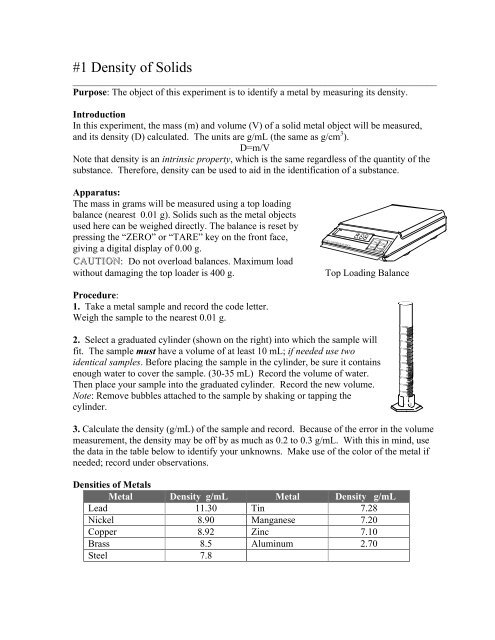You also want an ePaper? Increase the reach of your titles
YUMPU automatically turns print PDFs into web optimized ePapers that Google loves.
<strong>#1</strong> <strong>Density</strong> <strong>of</strong> <strong>Solids</strong><br />
___________________________________________________________________________<br />
Purpose: The object <strong>of</strong> this experiment is to identify a metal by measuring its density.<br />
Introduction<br />
In this experiment, the mass (m) and volume (V) <strong>of</strong> a solid metal object will be measured,<br />
and its density (D) calculated. The units are g/mL (the same as g/cm 3 ).<br />
D=m/V<br />
Note that density is an intrinsic property, which is the same regardless <strong>of</strong> the quantity <strong>of</strong> the<br />
substance. Therefore, density can be used to aid in the identification <strong>of</strong> a substance.<br />
Apparatus:<br />
The mass in grams will be measured using a top loading<br />
balance (nearest 0.01 g). <strong>Solids</strong> such as the metal objects<br />
used here can be weighed directly. The balance is reset by<br />
pressing the “ZERO” or “TARE” key on the front face,<br />
giving a digital display <strong>of</strong> 0.00 g.<br />
CAUTION: Do not overload balances. Maximum load<br />
without damaging the top loader is 400 g. Top Loading Balance<br />
Procedure:<br />
1. Take a metal sample and record the code letter.<br />
Weigh the sample to the nearest 0.01 g.<br />
TOP LOADER BALANCE<br />
2. Select a graduated cylinder (shown on the right) into which the sample will<br />
fit. The sample must have a volume <strong>of</strong> at least 10 mL; if needed use two<br />
identical samples. Before placing the sample in the cylinder, be sure it contains<br />
enough water to cover the sample. (30-35 mL) Record the volume <strong>of</strong> water.<br />
Then place your sample into the graduated cylinder. Record the new volume.<br />
Note: Remove bubbles attached to the sample by shaking or tapping the<br />
cylinder.<br />
3. Calculate the density (g/mL) <strong>of</strong> the sample and record. Because <strong>of</strong> the error in the volume<br />
measurement, the density may be <strong>of</strong>f by as much as 0.2 to 0.3 g/mL. With this in mind, use<br />
the data in the table below to identify your unknowns. Make use <strong>of</strong> the color <strong>of</strong> the metal if<br />
needed; record under observations.<br />
Densities <strong>of</strong> Metals<br />
Metal <strong>Density</strong> g/mL Metal <strong>Density</strong> g/mL<br />
Lead 11.30 Tin 7.28<br />
Nickel 8.90 Manganese 7.20<br />
Copper 8.92 Zinc 7.10<br />
Brass 8.5 Aluminum 2.70<br />
Steel 7.8<br />
ON CAL<br />
OFF TARE<br />
100<br />
90<br />
80<br />
70<br />
60<br />
50<br />
40<br />
30<br />
20<br />
10
Data and Results (<strong>Density</strong> <strong>of</strong> <strong>Solids</strong>)<br />
Name(s) ________________________________________________________________<br />
Identifying a Metal from its <strong>Density</strong><br />
Record Code Letter <strong>of</strong> your unknown(s)<br />
Code<br />
Letter<br />
Observations:<br />
Mass<br />
(g)<br />
Vol. H 2O in<br />
grad. (mL)<br />
Vol. H 2O +<br />
metal (mL)<br />
Vol. <strong>of</strong><br />
metal (mL)<br />
<strong>Density</strong><br />
(g/mL)<br />
Questions:<br />
1. Why must the volume <strong>of</strong> the metal sample be at least 10 mL?<br />
2. Are there any metals listed in the table that you could not identify using this procedure?<br />
What simple physical properties could be used instead?<br />
_______________________________________________________________________<br />
2<br />
Identity<br />
<strong>of</strong> metal
(Data and Results)<br />
Identifying a Metal from its <strong>Density</strong><br />
Record Code Letter <strong>of</strong> your unknown(s)<br />
Instructor’s Guide<br />
<strong>Density</strong> <strong>of</strong> <strong>Solids</strong><br />
Code<br />
Letter<br />
Mass<br />
(g)<br />
Vol. H2O in<br />
grad. (mL)<br />
Vol. H2O +<br />
metal (mL)<br />
Vol. <strong>of</strong><br />
metal (mL)<br />
<strong>Density</strong><br />
(g/mL)<br />
Identity<br />
<strong>of</strong> metal<br />
A 111.10 13.0 8.55 brass<br />
B 116.62 13.0 8.90 copper<br />
C 35.01 13.0 2.69 aluminum<br />
D 99.99 13.0 7.69 steel<br />
Observations:<br />
Questions:<br />
1. Why must the volume <strong>of</strong> the metal sample be at least 10 mL?<br />
2. Are there any metals listed in the table that you could not identify using this procedure?<br />
What simple physical properties could be used instead?<br />
_______________________________________________________________________<br />
1. The 50-mL graduated cylinder can be read to the nearest 0.2 mL at best, so to preserve<br />
three significant figures, the metal object must have a volume greater than 10 mL.<br />
2. The densities <strong>of</strong> Ni and Cu are identical to 3 significant figures. However, copper<br />
is reddish in color and nickel is magnetic, so there are other ways to distinguish<br />
Ni and Cu from one another.<br />
3
Instructor’s Guide<br />
<strong>Density</strong> <strong>of</strong> <strong>Solids</strong> (cont’d)<br />
Time: 30 min. This could be done by itself to fill a short class or combined with “<strong>Density</strong><br />
<strong>of</strong> Liquids” if at least an hour is available.<br />
Equipment and Materials: Per group:<br />
Items Number Comment<br />
50-mL graduates 1 Plastic<br />
wash bottles 1<br />
top loading balances 1<br />
metal slugs 2 ea aluminum, brass, steel, copper<br />
kimwipes 1 box<br />
safety glasses 30 per class<br />
Ideas/ Information<br />
Another way to measure the volume <strong>of</strong> the metal slug is by finding the diameter and height<br />
and using the volume <strong>of</strong> a cylinder.<br />
According to the company that supplied the slugs the measurements are “about”:<br />
12.5 to 12.7 cm diameter (d)<br />
50 ± 1 mm length (l)<br />
Thus the volume, V= πr 2 l can range from 6.01 mL to 6.46 mL.<br />
Brass is an alloy <strong>of</strong> copper and zinc, Cu and Zn.<br />
Bronze is an alloy <strong>of</strong> copper and tin, Cu and Sn.<br />
4


